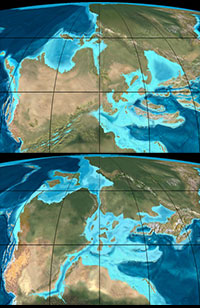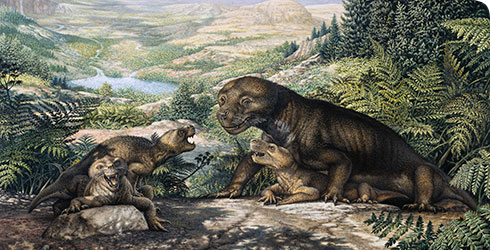End-Triassic mass extinction
After the cataclysmic Late Permian mass extinction, it took 10-20 million years for life to recover its previous diversity. But it did recover, and in significant new ways.
This was particularly true of vertebrates. Mammal-like reptiles flourished. Walrus-like reptiles, placodonts, appeared in the shallow seas. Sharks and fish diversified. And giant reptiles - the dolphin-like ichthyosaurs - became the top marine predators.
One of the main beneficiaries of the Late Permian mass extinction may have been the dinosaurs. Their early ancestors emerged within about 5 million years of the event.
While the first dinosaurs were only dog-size, by the end of the Triassic Period 6-metre-long giants had evolved. Then the good times came to an abrupt end as Earth was thrown into environmental chaos once again.
When did it happen?
Around 201 million years ago, in perhaps as little as 10,000 years.
What went extinct?
22% of all marine families, 53% of all genera, an estimated 76-84% of all species.
Most mammal-like reptiles and large amphibians disappeared, as well as many dinosaur groups.
In the sea, the largest entire group to die out was the strange eel-like conodonts. Reef ecosystems were decimated again. Ammonites, brachiopods and bivalves were also badly affected, with the latter losing over 90% of its species.

Comparison of part of Earth's northern hemisphere 220 (top) and 200 (bottom) million years ago showing the rift forming between North America and Europe. © Ron Blakey, Colorado Plateau Geosystems, Inc
Causes
This extinction is probably the least understood of the big five, because of the lack of accessible sediments for scientists to study. Most of the evidence suggests falling sea levels were probably responsible for the longer-term extinction patterns.
As the warm shallow seas decreased, reefs died and other marine organisms faced increased competition in less space. On land the lack of water would have led to more extreme temperatures and seasons.
When deep water spread back over the continents it was low in oxygen, resulting in further marine extinctions.
While the ultimate cause of this sea fall and rise isn’t certain, it appears to be associated with the start of a volcanic rift forming between the Americas and Africa and Europe. This would eventually produce the Atlantic Ocean.
At the end of the Triassic, very large eruptions occurred along the rift zone (known as the Central Atlantic Magmatic Province) for about 500,000 years. The environmental changes these caused put further stress on life on Earth.
Find out how life recovered and when the next mass extinction hit
Toolbox
The Great Extinctions book

What are the processes responsible for species extinction? And are we about to cause another mass extinction? Find out in this in-depth guide by Museum expert, Professor Norman MacLeod.
